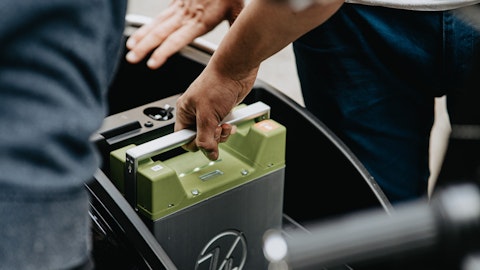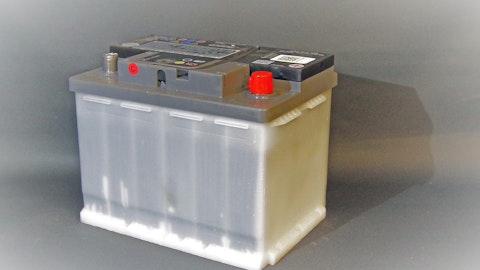Albemarle Corporation (NYSE:ALB) Q3 2023 Earnings Call Transcript November 2, 2023
Operator: Ladies and gentlemen, thank you for standing by. My name is Sheryl and I will be your conference operator today. At this time, I would like to welcome everyone to Albemarle Corporation’s Q3 2023 Earnings Call. [Operator Instructions] Thank you. I will now hand it over to Meredith Bandy, Vice President of Investor Relations and Sustainability.
Meredith Bandy: Alright. Thank you, Sheryl and welcome to Albemarle’s third quarter conference call. Our earnings were released after the close of market yesterday and you will find the press release and earnings presentation posted to our website under the Investors section at albemarle.com. Joining me on the call today are Kent Masters, Chief Executive Officer; and Scott Tozier, Chief Financial Officer; Netha Johnson, President of Specialties; and Eric Norris, President of Energy Storage, are also available for Q&A. As a reminder, some of the statements made during this call, including our outlook, guidance, expected company performance, timing of expansion projects, and growth initiatives may constitute forward-looking statements.
Please note the cautionary language about forward-looking statements contained in our press release and earnings presentation, which also applies to this call. Please also note that some of our comments today refer to non-GAAP financial measures. Reconciliations can be found in our earnings materials. And now, I will turn the call over to Kent.
Kent Masters: Thank you, Meredith. Before we begin, I am sure most of you have seen that this will be Scott’s last quarterly call as CFO. Scott is transitioning roles to become a strategic advisor, while Neal Sheorey will join the company as Executive Vice President and Chief Financial Officer on November 6. Scott has had a positive impact on the company since he joined in 2011. With his leadership, we have advanced Albemarle’s growth strategy and maintained our commitment to operating with people and planet in mind. In this new role, Scott will provide strategic advice into our long-range plans and will also be on hand to assist with Neal’s transition. I know you will join me in thanking Scott for his contributions to Albemarle over the past 13 years.
Our third quarter results reflect strong operating performance and continued volumetric growth in a challenging macro environment. Our net sales were up 10% in the third quarter versus the same period last year. However, adjusted EBITDA was down due to softer lithium market pricing and timing impacts of spodumene inventory from our JV-owned assets. Based on current market prices, we have revised our 2023 outlook, which still contemplates an increase in net sales between 30% and 35% year-over-year. We remain bullish about Albemarle’s long-term growth, our role in enabling a more resilient world and our strategy to deliver enduring value. In the third quarter, we made significant progress advancing these efforts. During the quarter, we signed agreements with Caterpillar to collaborate on solutions to support the full circular battery value chain and sustainable mining operations.
As part of the partnership, we will purchase an all-electric mining fleet for Kings Mountain and make our North American produced lithium available for use in Caterpillar battery production. We will also explore opportunities to collaborate with Caterpillar on R&D of battery cell technology and recycling techniques. With this collaboration, we and Caterpillar will be both customers and suppliers of each other with shared goals to pioneer the future of sustainable mining technology and operations. We also received a $90 million grant from the U.S. Department of Defense to help support the expansion of domestic mining and the production of lithium for the nation’s battery supply chain. The grant will be used to purchase fleet of mining equipment in support of the Kings Mountain restart.
Earlier this month, we finalized simplified commercial arrangements related to our joint venture transaction with Mineral Resources. Under the revised agreements, Albemarle will take full ownership of the Kemerton lithium processing facility and 50% ownership of the Wodgina spodumene mine in Australia and retain full ownership of the Qinzhou and Meishan lithium processing facilities in China. I will now hand it over to Scott to walk through our financial results.
Scott Tozier: Thanks, Kent and hello everyone. On Slide 5, let’s review our third quarter performance. Net sales were $2.3 billion, up 10% compared to last year. This increase was driven by higher energy storage volumes, thanks to expansion of our mining and conversion assets. Net income attributable to Albemarle was approximately $303 million, down 66% compared to the prior year. Similarly, diluted EPS was $2.57, down 66%. Higher net sales were more than offset by higher cost of goods sold, primarily due to inventory timing and I will discuss these timing impacts more in a moment. Our year-to-date results reflect the strong performance and significant growth we have achieved this year despite recent softer lithium pricing.
For the 9 months ended September 30, net sales are up 55% year-over-year and net income is up 42%. Looking at Slide 6, third quarter adjusted EBITDA was $453 million, a decrease of 62% year-over-year, driven primarily by softer lithium market pricing and timing impacts of spodumene inventory and energy storage. The Specialties business was also down due to continued lower volumes and pricing related to softness in certain end markets. For the first three quarters of 2023, adjusted EBITDA was more than $3 billion, up 38% against last year. Again, energy storage growth reflects the majority of that increase with both volumes and prices up year-over-year. On Slide 7, as Kent mentioned, we are lowering our total company outlook for 2023. As has been our practice, this outlook assumes recent lithium market price indices are constant for the remainder of the year.
And as a result, we have decreased the range for net sales. Under this methodology, 2023 total company net sales would be in the range of $9.5 billion to $9.8 billion. This range represents an increase in net sales of 30% to 35% over the prior year, driven by the ramp of our energy storage volumes. Our adjusted EBITDA outlook is expected to be in the range of $3.2 billion to $3.4 billion. This implies full year EBITDA margins of 34% to 35%. Our full year 2023 adjusted EPS outlook has also been adjusted to a range of $21.50 to $23.50. We expect our net cash from operations to be in the range of $600 million to $800 million. The decrease in adjusted EBITDA and net cash from operations reflects current lithium market prices and lower expected sales volumes at our Talison joint venture.
Our partner at Talison, elected not to take their full allocation in the second half of this year, and this has impacted our equity income for the period. Our CapEx guidance remains in line with previous forecasts at $1.9 billion to $2.1 billion, which as a reminder from last quarter, reflects 100% ownership of our conversion assets with the completed revised agreements with Mineral Resources. We expect to provide our full year 2024 outlook on our fourth quarter call in February. Turning to the next slide for more detail on our outlook by segment. Assuming recent lithium market prices remain constant through the rest of the year, we expect energy storage 2023 net sales in the range of $7 billion to $7.2 billion and adjusted EBITDA to be flat to slightly down on the year as timing impacts of higher priced spodumene more than offset higher net sales.
We are projecting that full year average realized pricing increases will be in the range of 15% to 20% year-over-year and energy storage volume growth in the range of 30% to 35% year-over-year. We continue to expect Q4 to see stronger production volumes as a result of project ramps. In 2024, volume growth is anticipated to continue as as Kemerton, Qinzhou and La Negra ramp to meet the expected demand from continued strong EV production. In the Specialties, we now expect net sales to be approximately $1.5 billion, with adjusted EBITDA expected to be down 40% to 45% year-over-year for the full year. This is due to continued softness in consumer electronics and elastomers, partially offset by strength in demand in other specialties end markets, including pharmaceuticals and oilfield.

We continue to monitor the situation in the Middle East and any impacts at our operations in Jordan. Currently, JBC is operating as usual without disruption to our supply chain. Macroeconomic and geopolitical uncertainties will impact market visibility in this business well into 2024. Ketjen’s 2023 full year adjusted EBITDA is now expected to be up 250% to 325% year-over-year due to higher pricing and volumes as well as productivity improvements. During the quarter, we saw higher volumes driven by high refinery utilization. We also saw benefits of higher contract pricing primarily for FCC products, which is expected to continue through 2023 and into 2024. We are encouraged to see inflation in Material and Energy costs moderating and expect this trend to continue through 2024.
On Slide 9, we have an experienced team that knows how to operate in a variety of price environments. Maintaining our disciplined growth mindset we are taking a comprehensive review of actions that will support our near-term profitability and cash flow. As we’ve done in the past, we’re reviewing our project spend and sequencing of our projects to preserve cash. We’re also implementing cost and efficiency improvements across our business. For example, we’ve reduced non-critical travel and are reducing discretionary spending. Our Albemarle Way of Excellence is the standard by which we choose to operate. Slide 10 provides an update to the targets we’ve made in manufacturing and procurement. We’re on track to exceed our goal of $170 million in productivity benefits in 2023.
In manufacturing, improvements to our overall equipment effectiveness to improve yield and utilization are expected to exceed $70 million in benefits. In procurement, we strategically sourced to capture lower raw material pricing. In 2024, we expect to increase these initiatives, targeting additional benefits across manufacturing, procurement and back office. Lowering operational costs in our business is critical to our success as we orient towards sustainable growth. As a reminder, most of our energy storage volumes are sold under long-term contracts with strategic customers. Our expected 2023 sales mix on Slide 11 remains unchanged from last quarter and reflects recent lithium market prices. We expect year-over-year energy storage volume growth to be in the range of 30% to 35% in 2023.
This is driven by successful execution and ramping new capacity as well as additional tolling. With additional conversion assets coming online in 2024 and beyond, we still anticipate a 20% to 30% CAGR in Albemarle sales volumes between now and 2027. And we remain on track to nearly triple our volumes to more than 300,000 tons. Slide 13, is the updated bridge for our energy storage adjusted EBITDA margins. Full year 2023 margins are expected to normalize in the 40% range from the very high rates we saw in 2022. As always, Talison equity income is included in our adjusted EBITDA on an after-tax basis, that tax drag impacted EBITDA margins by about 7% to 10%. The other impacts on the chart are relatively small and our offsetting. Higher lithium pricing is offset by other items.
This year, we had a 5% negative impact from MARBL JV accounting that goes away next year with the closure of the restructured MARBL JV. That leaves the largest impact to our margins at 20% spodumene inventory lag. We understand this inventory lag is complicated and can be difficult to forecast. So I want to spend a little bit more time on that. Through the Talison joint venture, Albemarle has access to one of the world’s best lithium resources. Greenbushes is a large, high-grade and, therefore, low-cost spodumene mine. We recognize our 49% share of Talison earnings in equity income and cash dividends. Our 50% share of Talison offtake also flows through inventories and cost of goods sold based on market pricing. The timing of inventories and sales can often drive short-term margin variations.
Excluding these timing impacts, we expect energy storage adjusted EBITDA margins to be in the range of 30% to 40%, even at today’s prevailing market pricing for lithium and spodumene. Turning to Slide 15. In the Talison joint venture, we recognized profit associated with our partners’ offtake immediately. We recognized profit associated with our offtake when the product is converted and sold which typically takes about 6 months from when we first extract spodumene from the ground. Throughout 2022 in the first half of 2023, Talison pricing on partner shipments was higher than that realized on our own shipments. Timing differences between the recognition of our profit on our partner’s offtake and our offtake resulted in about $800 million of benefit to EBITDA during that period.
As spodumene market prices decrease, we expect this effect to reverse as we recognized higher priced spodumene and cost of goods sold and lower prices in equity income. However, we expect this timing-related impact to be temporary, with no impact to adjusted EBITDA at steady market prices. Again, assuming today’s market prices are held constant, we expect energy storage adjusted EBITDA margins to average in the range of 30% to 40%. Turning to Slide 16. Albemarle’s capital allocation priorities remain unchanged. First, investing in high-return organic and inorganic growth, second, maintaining financial flexibility and our investment-grade credit rating; and lastly, funding our dividends. Planned expansions to deliver volumetric growth continue to progress across the company’s global portfolio.
Although, as I mentioned before, in this softer market, we are taking a hard look at the level of our CapEx spending and the sequence of our projects. As it relates to inorganic opportunities, we announced a few weeks ago that we decided not to pursue a binding agreement to purchase Liontown and formally withdrew our non-binding offer. While we had productive engagement with Liontown and as we learn more, we decided that moving forward with the acquisition at this time was not in Albemarle’s best interest. This reflects our disciplined capital allocation and M&A approach. As we look forward, we continue to evaluate a broad range of M&A opportunities. However, in the current environment, the scale of those opportunities are not as big. And we have many options available across 3 areas: lithium resources, process technology for our core business and for new advanced materials and battery recycling.
Turning to Slide 17. Our balance sheet flexibility is a competitive advantage that allows us to grow both organically and through acquisition as well as support shareholder returns. As of year-end 2023, we expect our leverage ratio to be 1.2x to 1.3x net debt-to-EBITDA. And with that, I’ll turn it back over to Kent for a market update and closing remarks.
Kent Masters: Thanks, Scott. On Slide 18, we highlight the continued growth in EV sales that reinforces our long-term growth opportunity. Year-to-date through September, EV sales remain on track for 40% year-on-year growth and show end market demand to be resilient. While the U.S. and Europe make up only about one-third of total EV production in ‘23 and ‘24, near term, we see potential challenges for EV growth in those regions related to economic softness and higher interest rates. We are monitoring any economic impacts to the seasonal acceleration in EV sales at the end of the year. Our long-term view of secular growth continues to be supported not only by the adoption of EVs, but transformations across mobility, energy, connectivity and health.
Slide 19 provides a view of lithium inventories across the value chain. Both upstream and downstream producers have continued destocking with very low levels of lithium inventory at cathode producers. Cuts to higher-cost supply have continued as some lepidolite producers, and merchant converters have reduced production. Turning now to Slide 20. We remain on track to achieve strong net sales growth up 30% to 35% year-over-year. This reflects our continued growth investments and the strength of our portfolio that have enabled us to overcome the near-term pricing challenges. We are disciplined in both how we operate and how we allocate capital providing an edge across economic cycles. Albemarle is a global leader with world-class assets and a diversified product portfolio positioned to supply key growth sectors.
We have a competitive advantage with vertically integrated assets and innovative advanced solutions designed to meet our customers’ needs. The actions we took this quarter, including our collaboration with Caterpillar, and the restructuring and simplification of the MARBL joint venture help us build on this advantage. The long-term growth trajectory of our end markets remain strong including continued growth in electric vehicles. Our strategy is clear to capitalize on this opportunity with a disciplined operating model to scale and innovate, accelerate profitable growth and advanced sustainability. With that, I’d like to turn the call back over to the operator to begin the Q&A portion.
See also 30 Most Stressful Jobs in the US and 25 Best Countries for Human Rights and Rule of Law.
Q&A Session
Follow Albemarle Corp (NYSE:ALB)
Follow Albemarle Corp (NYSE:ALB)
Operator: [Operator Instructions] Your first question comes from the line of Patrick Cunningham with Citi. Patrick, your line is now open.
Patrick Cunningham: Hi, good morning. So one of your JV partners is not taking the full allocation at Greenbushes and do you still plan to take your full volume allocation? And do you see any risk of production cuts in the first quarter, perhaps its concentrated stockpile?
Patrick Cunningham: That’s helpful. And then just given some of the recent price weakness headlines, dialing back EV targets, I’m just curious on more detail on how you’re thinking about growth investments and trajectory going forward. How has your thinking started to change on regions, project spending and sequencing of those projects?
Kent Masters: Yes. So we’re going through that at the moment. So we’re not prepared to really give guidance for next year’s capital plan, but we are taking a look at that. Everything we can do to cut capital, but without really impacting the long-term growth trajectory or the growth projects that we’ve developed out there. So there is some flexibility around sequencing and we will be able to put some projects out slightly without really changing the long-term profile for that. And that’s the work that we’re doing now, and we will be able to give guidance on that in the February call.
Patrick Cunningham: Alright, thank you.
Operator: Your next question comes from the line of Josh Spector with UBS. Josh, your line is open.
Josh Spector: Hi, thanks for taking my question. I guess, first, I wanted to ask on kind of lithium pricing and specifically the realized pricing for Albemarle. And just kind of thinking about a scenario where spot goes less than $20, so say, $18 per kilogram. What happens to the other 80% of your contracts? You’ve talked about floors, you’ve indicated that there above or at the high end of the cost curve. But what really does that mean? In that scenario, I guess, what does Albemarle realize in terms of pricing?
Eric Norris: Good morning, Josh, it’s Eric. As you know, we don’t give precise price guidance for our overall portfolio. But let me try to help and give you some perspective around this. First off, obviously, a spot price realized in China, will look different as you look at other market pricing around the world. There is – most of the supply or a lot of the supply comes from China, they are transactional and VAT considerations that would translate that to a higher price oftentimes outside of China. We have floors on our 80% of our index reference contracts. We have a variety of different floors. We don’t disclose that, but it’s designed to give us protection so that we can continue to operate well, continue to pursue growth capital in the near-term and to sustain the margins that Scott was talking about.
And as we look forward, I mean, we are – I’d have to little bit perplexed as to why price is where it is. These are levels that for a great number of the higher-cost projects we would expect supply to come off, and in fact, have seen supply come off, should prevail. We’d expect to see potentially other resources or other projects be slowed down. From our perspective, though, we have a growth plan that’s double-digit growth next year. We feel comfortable with the protection of our contracts give us and importantly, the low-cost position we have going forward in our portfolio.
Josh Spector: Yes, thanks, Eric. And I guess I wanted to follow-up just on the margin comments that you made, Scott. So the range that you gave, I mean, it’s different than you go back a couple of years ago, you talked about 45% plus. And I believe at that time, you said you could maintain those margins in a lower price environment. I guess I don’t know if I’m remembering right or if anything has changed, but what accounts for the difference?
Scott Tozier: Yes. I think the difference, Josh, is that when we made those mid kind of 40% comments, we were thinking about a mid-cycle type of pricing. As we look at this 30% to 40% that I commented on today, that’s really at today’s prevailing prices. And again, it’s based on constant pricing as opposed to some of the volatility, which is going to distort our margins either higher as prices go up or lower as prices come down.
Josh Spector: Okay, thank you.
Operator: Your next question comes from the line of Joel Jackson with BMO Capital Markets. Joel, your line is open.
Joel Jackson: Good morning, Eric. So I think Eric, you just said you were perplexed how low prices have come down to maybe low 20s here, LCE – so you said you’re considering reinvestment economics. So maybe you could talk about why you think prices have gone down to where they are? Is it lepidolite? Is it African spodumene? Is it something else? What do you think? Everyone is still there?
Operator: We are here. [Operator Instructions]. Thank you.
Meredith Bandy: Hi, can you hear us on the line?
Operator: We can hear you.
Eric Norris: Shanelle, can you hear us?
Operator: Yes, we can hear you.
Eric Norris: Okay. Okay. Sorry, not sure what happened there. So Shanelle, I’ll – if it’s okay, and you can hear me, just confirming?
Operator: Yes, I can hear you.
Eric Norris: Okay. So I’ll continue to answer Joel’s question. Joel, so I apologize for the interruption…
Joel Jackson: Can we start from the beginning, Eric, if that’s okay? I didn’t hear it anyway.
Eric Norris: Yes. So what I was describing is that we do a lot of work to model supply and demand. And if you look last year, this year, next year, remove for a moment, what we know has happened this year, which has been an inventory correction in the supply chain, the industries by our reckoning is operating at us if you look at supply or demand over supply about a mid-90s capacity utilization rate. So that’s the part that’s perplexing. And in any other market, at those levels, you wouldn’t see pricing fall like it has. Now we have had an inventory correction this year. It’s largely run its course, at least at the cathode level in the largest market in the world, and that’s one of the slides we shared with you. Any inventory correction further in the supply chain, we would expect on balance to occur or be behind us or certainly be behind us in the balance of this year.





